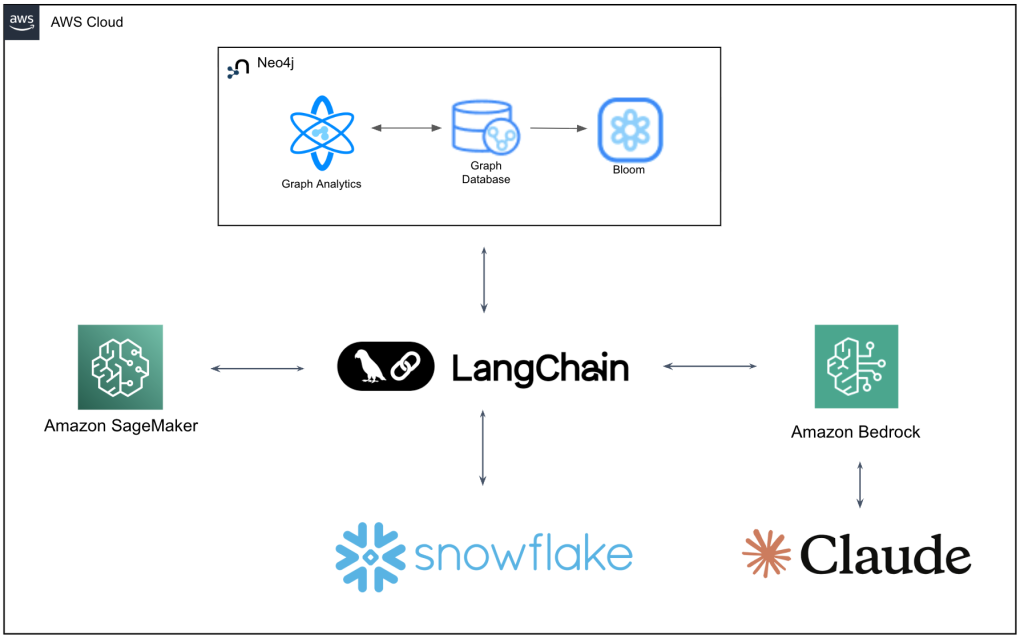Technology Media Company Achieves 10x Faster GenAI Analytics with Neo4j GraphRAG, Amazon Bedrock, and Deloitte
Gaming giant teams with Deloitte to deploy a natural language query platform that uses LLM-powered agents and knowledge graphs to transform traditional user input-driven insight discovery.
10x faster
Time-to-insight compared to traditional analytics
92%
Reduction in analyst time spent on routine data requests
150+
Business users actively using the solution daily

In gaming, timing is everything. A single promotional decision can drive—or lose—millions of dollars in revenue.
“Our executives used to wait two to three weeks for analysts to compile reports about franchise performance or promotional impact,” explains a Senior Solution Architect at the company. “That’s too long in today’s competitive gaming market. We needed a way to democratize access to our enterprise data while ensuring every insight remained completely trustworthy.”
The company faced a deeper challenge than speed. Their business data lived across multiple systems—sales figures, customer feedback, market events, promotional data. Traditional databases couldn’t map the complex relationships between these sources.
“Our solution needed to understand the deep relationships between different aspects of our business – how a competitor’s launch affects our sales, how promotional timing impacts revenue, how development decisions influence player engagement,” a Senior Solution Architect at the company shares. “We needed a solution to join data between tables to think contextually, like our best analysts do.”
The solution came from an innovative approach which combined knowledge modeling with the generative power of the language models. The underlying metainformation of the source entities was converted to semantic knowledge graphs to provide context to the language model to generate structured query from natural language.
Working with Deloitte and Amazon Web Services (AWS), the company built a natural language query solution— a platform that would transform how the company uses its enterprise data not just for insight discovery but meaningful, actionable data insights.
From Weeks to Minutes: How Technology Media Company Reinvented Data Access
The company’s early attempts at AI analytics exposed limitations. Vector databases could find similar text in documents, but missed crucial domain and semantic relationships between entities. When asked about a game’s holiday sales performance, these systems would retrieve fragments about “holidays” and “sales” without understanding how pricing strategies, competitor launches, and market conditions are interrelated.
“The vector approach gave us pieces of the puzzle but couldn’t assemble them,” explains the Senior Solution Architect. “We’d get accurate but incomplete answers. An executive asking about a game’s Black Friday performance might receive raw sales numbers, but miss vital context about how our promotional timing compared to competitor launches.”
Simple chatbots presented a different problem. While they generated human-like responses about business performance, they couldn’t prove where their information came from.
“Our executives wouldn’t bet millions on an AI response they couldn’t trust,” says the Senior Solution Architect. “We needed every insight traceable to source data. When our system claims a promotion drove specific results, we must verify that chain of reasoning.”
Rather than treating business data as rows and columns in a database, the company envisioned its solution as an investigator’s evidence board, with every piece of information connected by meaningful and explainable relationships.
“Most companies store data in isolated tables,” explains Rajib Deb, Specialist Leader, AI and Data Engineering, Deloitte Consulting LLP. “We instead envisioned the company’s business as interconnected concepts – games connect to promotions, promotions to market events, market events to revenue. This graph-based interconnected concepts approach mimics human capability to understand the world model for reasoning and logical understanding for responding to queries. The graph in this case evolved to a knowledge graph, which captured the model of the game analytics world based on which we wanted the LLM-powered agent to respond to user queries.”
The project demanded specialized expertise. Deloitte brought enterprise AI experience and knowledge modeling. AWS provided foundation models through Amazon Bedrock. Neo4j supplied the graph technology to map business relationships at scale.
Technology Media Company and Deloitte’s journey to select a graph database platform was methodical. The team evaluated multiple options, including traditional relational databases with complex joins, document databases, and other graph solutions.
“We needed three key capabilities,” explains the Senior Solution Architect. “First, the ability to model complex business relationships without performance-killing joins. Second, native support for both structured and unstructured data. And third, the ability to scale as our knowledge graph grows.”

Above: Technology Media Company’s AWS Cloud architecture
Neo4j emerged as the clear choice for several reasons:
- Native graph processing for complex relationship queries that would otherwise require dozens of joins in traditional databases
- Built-in graph data science capabilities for future analytics expansion
- Enterprise scalability through Neo4j AuraDB on AWS
- Strong integration with AWS services including Amazon Bedrock
- Extensive developer tools and community support
“The decision ultimately came down to Neo4j’s maturity in the enterprise space and the potential to evolve to a knowledge graph to develop a world model that is aligned to the use case at hand,” notes Deloitte’s Rajib Deb. “Other solutions could store graph data, but Neo4j’s two decades of experience in mission-critical deployments gave the company confidence our natural language query solution could scale.”
GraphRAG is a class of retrieval augmented generation (RAG) patterns that use a knowledge graph to retrieve information and send it as facts to foundational models to refine the natural language responses and reasoning. GraphRAG combines the strengths of two essential components: knowledge graphs, and foundational models and LLMs (Generative AI).
Deloitte’s first step was to construct a knowledge graph to map the meta information of the company’s existing knowledge stores.
“Building a knowledge graph isn’t like designing a standard database,” explains Deb. “We first had to map the company’s entire business domain. Then we designed a system of specialized AI agents that could traverse these relationships intelligently.”
The company’s natural language query solution uses semantic memory to help its AI agents learn from each interaction. This means it stores more knowledge about the company with every query, while staying grounded in verifiable data relationships. The system works by intelligently querying the company’s enterprise data in Snowflake. When users ask questions in natural language, the solution uses the knowledge graph layer in Neo4j’s graph database to understand what data it needs, then generates precise SQL queries to extract relevant information from Snowflake.
“Our data analysts used to spend hours writing complex SQL queries across multiple Snowflake tables,” says the Senior Solution Architect. “Now our natural language query solution instantly identifies the right tables and relationships through its knowledge graph, making our Snowflake data instantly accessible to business users.”
Today, when an executive asks about a specific game’s Thanksgiving performance, the natural language query solution can pull much more than sales numbers: it traverses the knowledge graph to understand promotional timing, competitor launches, and historical patterns. The system then generates a response that explains not just what happened, but why. Here’s how it works:
- User asks question to an LLM based agent
- Agent retrieves information from a Neo4j knowledge graph to understand what information and how to retrieve the information to answer user question
- Agent retrieves the required information from the KG, analyzes, finds correlation and crafts the final response
- Agent shares the response with the user and waits for more follow-up questions
“Think of it like having a team of experts working together,” shares Kasi Muthu, Senior Partner Solutions Architect, AWS. “One expert understands the question, another knows where to find relevant data, and another explains the findings. Amazon Bedrock makes this possible.”
This architecture solved three critical challenges:
Accuracy: The implementation of a reflective pattern where a reviewer validates the SQL both syntactically and functionally improved accuracy. Claude Sonnet (AWS Bedrock) gave the team better accuracy in SQL generation than other models they
Explainability: Every response can be traced back to how it was crafted by traversing the rich semantic information stored in the graph
Context: The system understands the domain relationships to be able to respond with just facts, but with additional insights
Transforming Decision-Making at the Speed of Play
The impact of the company’s graph-enhanced AI platform extends far beyond faster queries. Where business leaders once waited weeks for analysis, they now engage in real-time data exploration. “An executive recently uncovered in seconds what would have required two weeks of analyst time,” notes the Senior Solution Architect at Technology Media Company. “But speed isn’t the real victory – with Neo4j we have confidence in the answers.”
This confidence stems from the solution’s unique architecture. Every insight can be traced through the knowledge graph to its source data. When making decisions about product launches or promotional timing – where millions in revenue hang in the balance – this verification capability proves invaluable.
The numbers tell a compelling story:
- Analysis tasks that once took 2-3 weeks now complete in seconds
- The platform serves 150 users across the company, from data analysts to franchise executives
- Users can trust AI-generated insights with direct links to source data
But perhaps more significant are the cultural implications. “We’re seeing a fundamental shift in how our organization approaches data,” explains the Senior Solutions Architect at Technology Media Company. “People who would never write SQL are now having sophisticated conversations with our enterprise data.”
The success has prompted ambitious expansion plans. Technology Media Company intends to evolve the natural language query solution from a sales analytics tool into a comprehensive knowledge platform. Future capabilities will include automated pattern discovery in game development data, integration of player behavior analytics, and real-time market response analysis.
“This isn’t just about making AI faster – it’s about making it trustworthy enough for billion-dollar decisions,” says AWS’ Kasi Muthu. “The combination of knowledge graphs and foundation models opens new possibilities for enterprise AI.”
For Deloitte and AWS, Technology Media Company’s implementation serves as a blueprint for trustworthy enterprise AI. “We’re just beginning to understand the possibilities,” concludes Technology Media Company’s Senior Solution Architect. “The real power lies in combining human expertise with AI that truly understands our business context.” For an industry that moves at the speed of play, that understanding could make all the difference.
Get in Touch
Curious about what insights you could unlock for your business with graph-powered solutions? Let’s talk — reach out, and we’ll get in touch.

